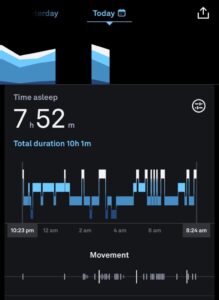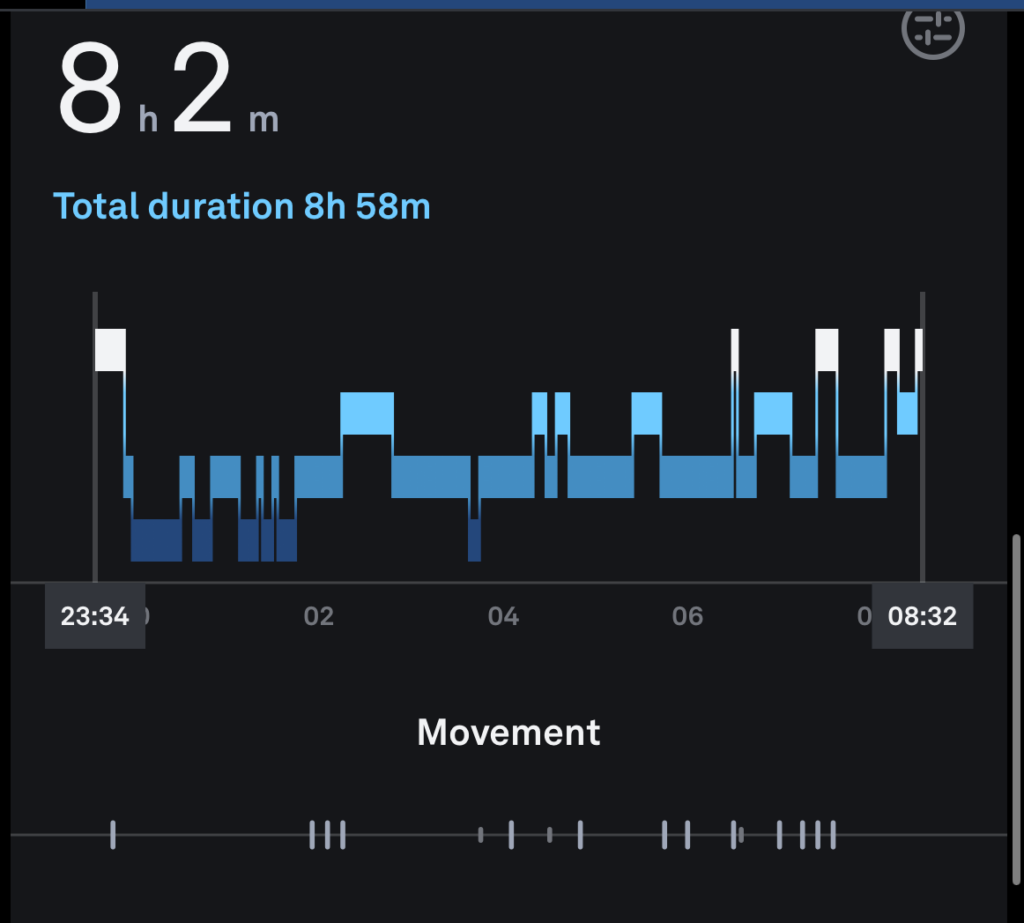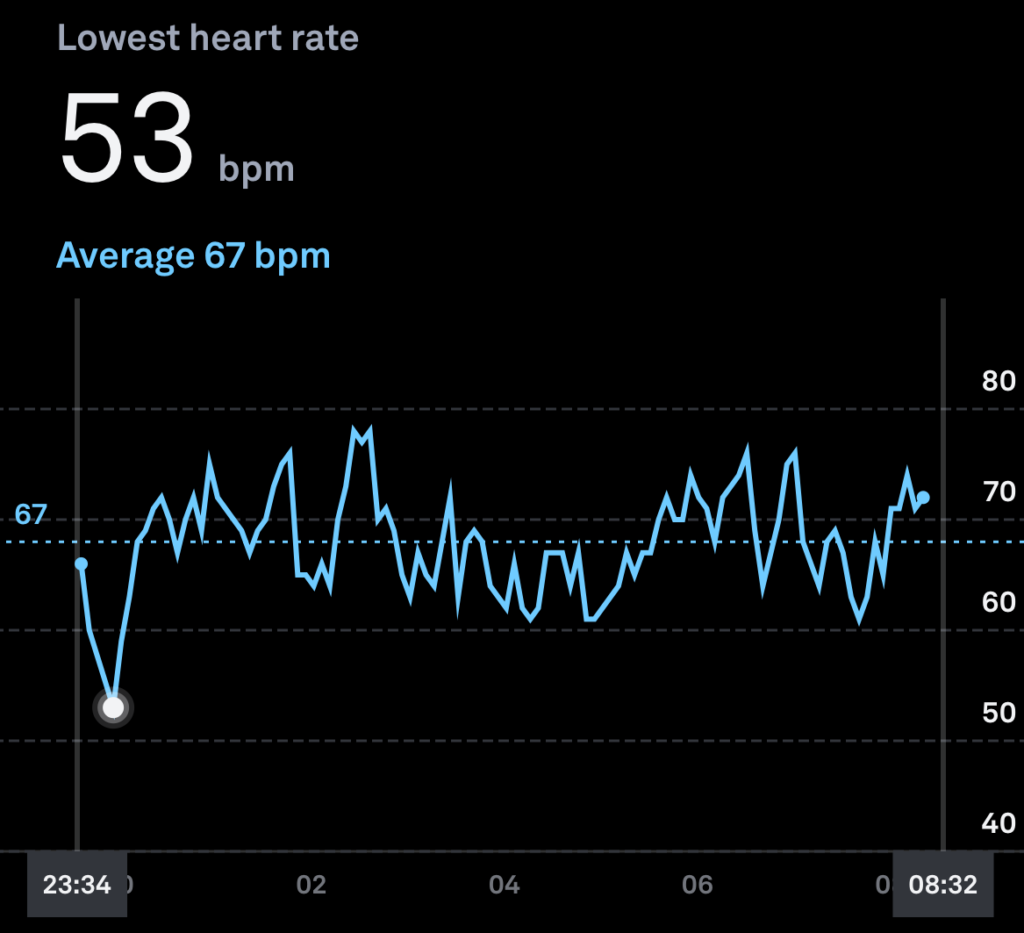If you’re getting a full night’s sleep but still feel tired during the day, there’s a chance that your nighttime movement is disrupting your sleep quality. While it’s normal to shift periodically, some people might toss and turn more than they realize.
Oura can help you understand how your nighttime movements impact your sleep. Looking at the Nighttime Movement graph, you can see if excess activity is affecting your sleep quality by comparing your movement patterns with your sleep phases and resting heart rate (RHR).
Excessive nighttime movement can impact how restorative your sleep is — affecting your mood, productivity, mental sharpness, and health. Keep reading to find out how you to leverage this feature to sleep better.
What Is Nighttime Movement on Oura?

On the Sleep tab on the Oura App, members can see their Movement graph by tapping the arrow just below Sleep Stages.
The Movement graph displays five-minute time blocks as lines, which represent the intensity of your movement based on height and color:
- A Tall, White Line = High-intensity movement. You were likely awake.
- A Medium, Light Grey Line = Mild intensity movement. You were likely tossing and turning.
- A Short, Dark Grey Line = Low-intensity movement. You’re shifting in your sleep, and it may impact your sleep quality.
- A Blank Spot = No movement. You were sleeping peacefully
Very low movement typically correlates to long periods of deep or REM sleep, a good sign of high-quality rest. Excess movement may impact elements of your Sleep Score, which you can see via three contributors: higher Awake Time, a lower Efficiency, or frequent enough wake-ups and movement to impact your Restfulness. For a breakdown of all of your Sleep data, see this comprehensive guide.
READ MORE: Oura Sleep Graphs
How Can You Use This Feature?
If you feel refreshed in the morning and energetic during the day, there’s most likely nothing to worry about, even if you move around at night. If you’re interested in investigating, however, your Movement graph enables you to line up data within a single night as well as compare your sleep between nights.
To look at a single night’s sleep, you can now visually align moments of high activity with your sleep stages and RHR. Look for periods when a sudden increase in movement aligns with awake time in your sleep stages or spikes in your RHR. Both can signify that something is disturbing your sleep.
As you become familiar with your movement patterns over time, you can start to identify habits that might impact your sleep. Excess nighttime movement has many possible causes, many of which are tied to our daily routines and habits.
3 Tips to Reduce Nighttime Movement
1. Avoid sources of stress before bed.
Things like stressful conversations, scary movies, workouts, late meals, or stimulants like caffeine or alcohol can activate your fight-or-flight system in the evening. A relaxed mind, with the rest-and-digest system activated, helps you wind down before bed. Try writing your thoughts or to-do lists in a journal or doing an evening meditation.
| Member Tip: Access guided meditations and breathing exercises in the Explore content on the Oura App. |
RELATED: Restless Sleep? How to Reduce Tossing and Turning at Night
2. Optimize your sleeping environment.

Exposure to light and darkness is one of the main regulators of sleep. Try using blackout curtains, a sleeping mask, and avoiding blue light at least a couple of hours before bed.
Additionally, noise can wake you up in the middle of the night. If you can’t control the sound levels of your surroundings, learning to sleep with earplugs, white noise, or noise-canceling headphones or earbuds can help keep noise levels consistent.
Other tips to optimize your sleeping environment include keeping your bedroom cool at night. Also, choose bedding that doesn’t make you overheat once you’ve fallen asleep.
Finally, is it possible that you’re sleeping on a mattress that doesn’t adequately support your body? Check your sleep ergonomics. A comfortable bed and pillow that supports your head and back are the cornerstones of restful sleep.
READ MORE: How to Choose the Best Bedding for a Better Night’s Sleep
3. Consider your sleeping arrangements.
Is someone else causing your nighttime movements? Be it your partner or your pet, you all deserve peaceful nights. Try multiple sleeping arrangements until you find an optimal solution.
If it’s a partner, try experimenting with separate blankets; you don’t want to be woken up by an unconscious fight for the comforter.
If it’s an overactive dog or cat that keeps you restless, make your space your space; give your cute companion their own comfortable sleep space outside the bedroom, and keep your door closed until morning.
READ MORE: What Is a “Sleep Divorce” & Is It Right for Your Relationship?












